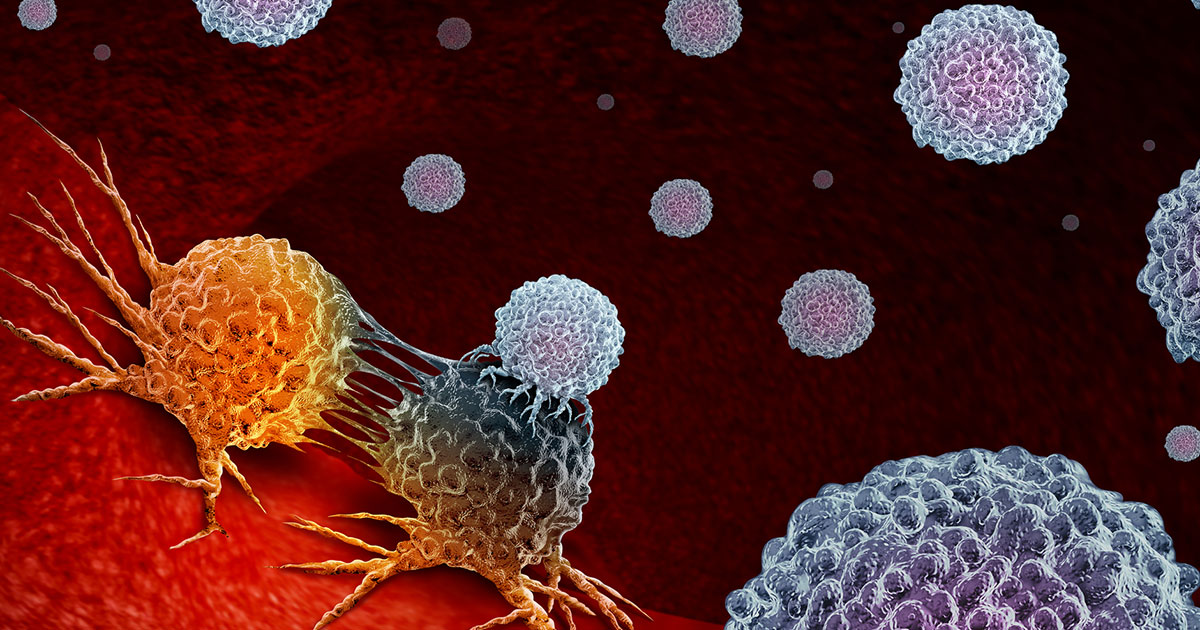
The concept of immunotherapy to treat cancer and other diseases is more than a century old, and immunotherapy drugs have been used to treat cancer for decades. But it wasn’t until the approval of so-called checkpoint inhibitors in 2011 that immunotherapy drugs began to develop into a first-line, standard-of-care treatment for some cancers.
“Almost every patient asks about immunotherapy,” says Arturo Loaiza-Bonilla, MD, Director of Clinical Research at Cancer Treatment Centers of America® (CTCA).
And it’s no wonder. In the decade since the U.S. Food and Drug Administration approved the first checkpoint inhibitor, the treatment strategy has been approved for many difficult-to-treat cancers, including melanoma and lung cancer. Former U.S. President Jimmy Carter credits the drug pembrolizumab for killing metastatic melanoma lesions on his brain and lungs
As groundbreaking as immunotherapy drugs have been, challenges remain.
These drugs are not approved for all cancers and have shown to have little or no effect on a large percentage of patients. And checkpoint inhibitors and CAR T-cell therapy, the newest form of immunotherapy, have may have serious side effects in some patients.
To find new ways to expand the use of immunotherapy drugs, scientists and doctors are researching new ways to increase the use of these therapies and help stimulate the immune system to better recognize and attack cancer cells.
“We know that immune checkpoint inhibitors have become pivotal in managing many malignancies across multiple disease types,” Dr. Loaiza-Bonilla says. “And we’ve gotten to the point where, for many cancers, it has become a standard of care. Now, we’re looking at immunotherapy with different molecules, and a number of new biomarkers are emerging.”
This article will explore some cutting-edge research underway in immunotherapy, including:
- Looking beyond PD-1 to find new immune checkpoints
- How immunotherapy may be able to treat a rare form of eye cancer
- Does the protein MR1 represent the future of immunotherapy?
Are you interested in learning more about immunotherapy at CTCA®, or want to schedule a second opinion on your cancer diagnosis or treatment plan? Call us or chat online with a member of our team.
What is immunotherapy?
More than 130 years ago, New York physician William Coley, MD, postulated that injecting tumors with live bacteria may attract enough immune cells to that part of the body to attack not only the germs, but the tumor as well. The doctor and the “Coley’s toxins” he used were soon dismissed by colleagues, at a time when other forms of cancer treatment, such as radiation therapy, proved to be more promising. Years later, however, Coley would be crowned the “father of immunotherapy.”
While Coley’s experiments were crude and often unsuccessful, his theories were solid. Cancer grows because of its ability to avoid, deceive and hide from the immune system. Immunotherapy drugs help give the immune system the tools it needs to find cancer cells and kill them.
While many only associate immunotherapy drugs as checkpoint inhibitors, many other types of immunotherapy drugs are designed to help the immune system marshal its forces against cancer cells. They include:
Cytokines: These are natural proteins that help marshal immune cells and direct them toward their target. Cytokines for cancer treatment are manufactured and injected or infused.
Vaccines and immunomodulators: They work by introducing substances that attract immune cells to a specific spot in the body.
CAR T-cell therapy: This novel therapy uses immune cells that have been re-engineered to attack specific receptors on cancer cells.
Finding new checkpoints
When traveling by plane, passengers may have to go through several checkpoints at the airport to ensure they’re getting on the right flight and are not a security risk. Our cells also pass by checkpoints—receptors on the surface of immune cells that help the immune system determine whether the cells are harmful. Cancer cells, however, have ways of disguising themselves and passing by these checkpoints receptors without provoking an immune attack.
To boost the immune system’s ability to better recognize and attack cancer cells, scientists developed checkpoint inhibitors that unmask cancer cells to the immune system. So far, these drugs target only two checkpoint receptors on cell surfaces: CTLA4 and PD-1/PD-L1.
But knowing that additional checkpoints exist, scientists are looking for ways to target them with new immunotherapy drugs. Three such targets—LAG-3, TIM-3 and TIGIT—have drawn special attention. These immune checkpoint proteins are believed to help regulate the immune system to help prevent autoimmune diseases that occur when over-active immune cells attack healthy cells. When these receptors malfunction, it may result in several factors that contribute to cancer growth, including:
T-cell exhaustion: When T-cells don’t have the strength or not in sufficient numbers to launch a strong immune response
Reduced cytokine production: When the body produces too few cytokines, or proteins that help regulate the production of immune cells
Regulatory T-cell (T-regs) promotion: When T-regs (T-cells meant to shut down an immune response) are hijacked and used by cancer cells
Researchers are exploring ways to harness the power of these different immune receptors so they can better recognize and attack cancer cells.
Effective combinations
Doctors and researchers also are looking into how combinations of checkpoint inhibitor drugs may work better than a single drug on its own. For instance, doctors may use a combination of nivolumab (Opdivo®), a PD-1 inhibitor, with ipilimumab (Yervoy®), a CTLA-4 inhibitor, to treat some patients with non-small cell lung cancer.
Recent research shows a LAG-3 agent called relatlimab, used in combination with the nivolumab, may jumpstart the immune system in patients with advanced melanoma. And researchers at the University of Hawaii are exploring how two developing drugs—cobolimab, a TIM-3 agent, and dostarlimab, a PD-1 inhibitor—may work together to treat several solid tumors and blood cancers.
“Much of the success of checkpoint inhibitors has been with PD-1/PD-L1 inhibition, but it’s only logical to assume there are other immune checkpoints or T-cell features that can be targeted,” Dr. Loaiza-Bonilla says. “And, theoretically, if you expand the number of immune checkpoints you can target, you’re also expanding the potential combinations that may be used for therapy.”
CTCA currently is involved in several clinical trials that Dr. Loaiza-Bonilla hopes will lead to more uses for currently approved immunotherapy drugs, tapping the potential of new checkpoints, such as TIM-3 and LAG-3. “We’re very excited to be part of those efforts and to be able to help more patient with these new molecules and agents,” he says.
What they mean
When referring to protein receptors targeted by cancer drugs, it’s often easier to use the acronym instead of the full name. Here’s what those acronyms stand for:
- CTLA4: Cytotoxic T-lymphocyte-associated protein 4
- PD-1 and PD-L1: Programmed cell death protein 1 and its ligand, a corresponding protein on another cell that generates a reaction
- LAG-3: Lymphocyte activation gene 3
- TIM-3: T-cell immunoglobulin and mucin domain 3
- TIGIT: T-cell immunoglobulin and ITIM domain
New hope for a rare cancer
Researchers have homed in on a form of immunotherapy called bispecific fusion proteins as a potential treatment for metastatic uveal melanoma—a rare, but often lethal, form of eye cancer.
In clinical trials, the drug tebentafusp was shown to extend the life of patients with uveal melanoma, also called intraocular melanoma. While rare, it is the most common form of eye cancer and is often diagnosed in advanced stages, which may make it more difficult to treat. Checkpoint inhibitor drugs have produced positive outcomes in some patients with melanoma, but they have not been as effective against uveal melanoma.
Tebentafusp belongs to a class of drug called bispecific fusion proteins. And while the study was designed to treat a rare form of cancer, findings may eventually help lead to treatments of more common cancers.
Fusion proteins are made by combining parts of two different genes. In some cases, fusion proteins occur naturally in the body and may raise the risk of cancer. For example, the BCR-ABL gene, which may be found on a mutated chromosome dubbed the Philadelphia chromosome, is diagnosed in patients with certain types of leukemia.
Tebentafusp is designed to latch on to two specific proteins—one on a cancer cell and one on a T-cell. Consider the drug sort of a treatment liaison, bringing the two parties closer together. When that occurs, the T-cells better recognize the cancer cell and are better able to kill it.
“Having a bispecific antibody may be helpful because it can not only attach to the biomarker that we’re looking for, but also to something expressed on the T-cell,” Dr. Loaiza-Bonilla says. “It’s more efficient and could be a potential game-changer.”
In May, the FDA approved amivantamab (Rybrevant™), the first bispecific antibody to treat cancer. It targets EGFR and MET receptors on tumor cells to treat patients with locally advanced or metastatic non–small cell lung cancer with certain EGFR mutations.
MR1: The magic molecule?
Experts don’t expect a cure for cancer because cancer isn’t just one disease. It’s hundreds of diseases that affect every patient differently. Even immunotherapy drugs that have produced many positive outcomes don’t work for all cancers, may not work on all patients and may produce vastly different outcomes from patient to patient.
But what if one immunotherapy drug could be used to treat a wider variety of cancers and work well for most patients? That’s the promise behind research using immune cells called killer T-cells to recognize a protein on cells called MR1. Early research suggests that MR1 may be a universal target that allows the immune system to destroy cancer cells while keeping healthy cells virtually untouched.
What is MR1?
MR1 is a protein found on many cells in every human. Scientists also suspect it’s a cellular tattletale. When it detects defects in cells, MR1 alerts the immune system to destroy the cell, leaving surrounding healthy cells alone.
Using the CRISPR-Cas9 gene-editing tool, researchers were able to engineer killer T-cells with special receptors designed to recognize MR1 on cancerous cells and kill them. In early lab research, according to a study published in Nature Immunology, these engineered T-cells were able to kill “most human cancer types,” including lung, breast, colon, prostate, ovarian and blood cancer cells, while ignoring healthy cells.
While research is still evolving, development of an MR1-targeted treatment would have tremendous advantages over currently immunotherapies because:
- It may work on blood cancers and solid tumors: Currently, CAR T-cell therapy appears to be a treatment option reserved only for blood cancers.
- It appears to only target MR1 on cancer cells, not on healthy cells. One of the side effects of immunotherapy is it may cause the immune system to attack healthy cells.
- Unlike other proteins that may vary its properties from person to person, MR1 is virtually identical in everyone. That means treatments may not need to be personalized with re-engineered T-cells like they are with CAR T-cell therapy or other cancer treatments.
“Cancer-targeting via MR1-restricted T-cells is an exciting new frontier,” says Andrew Sewell, Distinguished Research Professor and lead researcher at Cardiff University’s School of Medicine in England. “It raises the prospect of a ‘one-size-fits-all’ cancer treatment; a single type of T-cell that could be capable of destroying many different types of cancers across the population. Previously nobody believed this could be possible.”
Are you interested in learning more about immunotherapy at CTCA, or want to schedule a second opinion on your cancer diagnosis or treatment plan? Call us or chat online with a member of our team.



